Assist students in accessing labor market in industry 4.0
Industry 4.0 (4th Generation Industrial Revolution) is the digital
transformation of industrial markets (industrial transformation) with smart
manufacturing currently on the forefront. It is also a term appears much in the
mass media as well as in our daily life. In Vietnam, in terms of perception, we
have accessed rapidly to industry 4.0 with a whole series of discussions and
research. This revolution is expected to bring great benefits to human life.
However, for the nation based mainly on resource extraction and cheap labor
such as Vietnam, its impact at the early stage is evaluated to be negative. Manual
labor in textile, assembly industry and traditional agriculture will be affected
greatly. According to the International Labor Organization (ILO) report in July
2016, 70-75% of simple and manual jobs in these sectors may be replaced, tens
of millions of traditional workers may lose their jobs; new energy or materials
will greatly affect the exploitation and use of resources.
Not being out of the reach of industry 4.0 affection, higher education and
students’ access to the labor market have many opportunities and challenges.
This article focuses on identifying the effects of industry 4.0 on employment as
well as on student labor market access at the side of universities’ support.
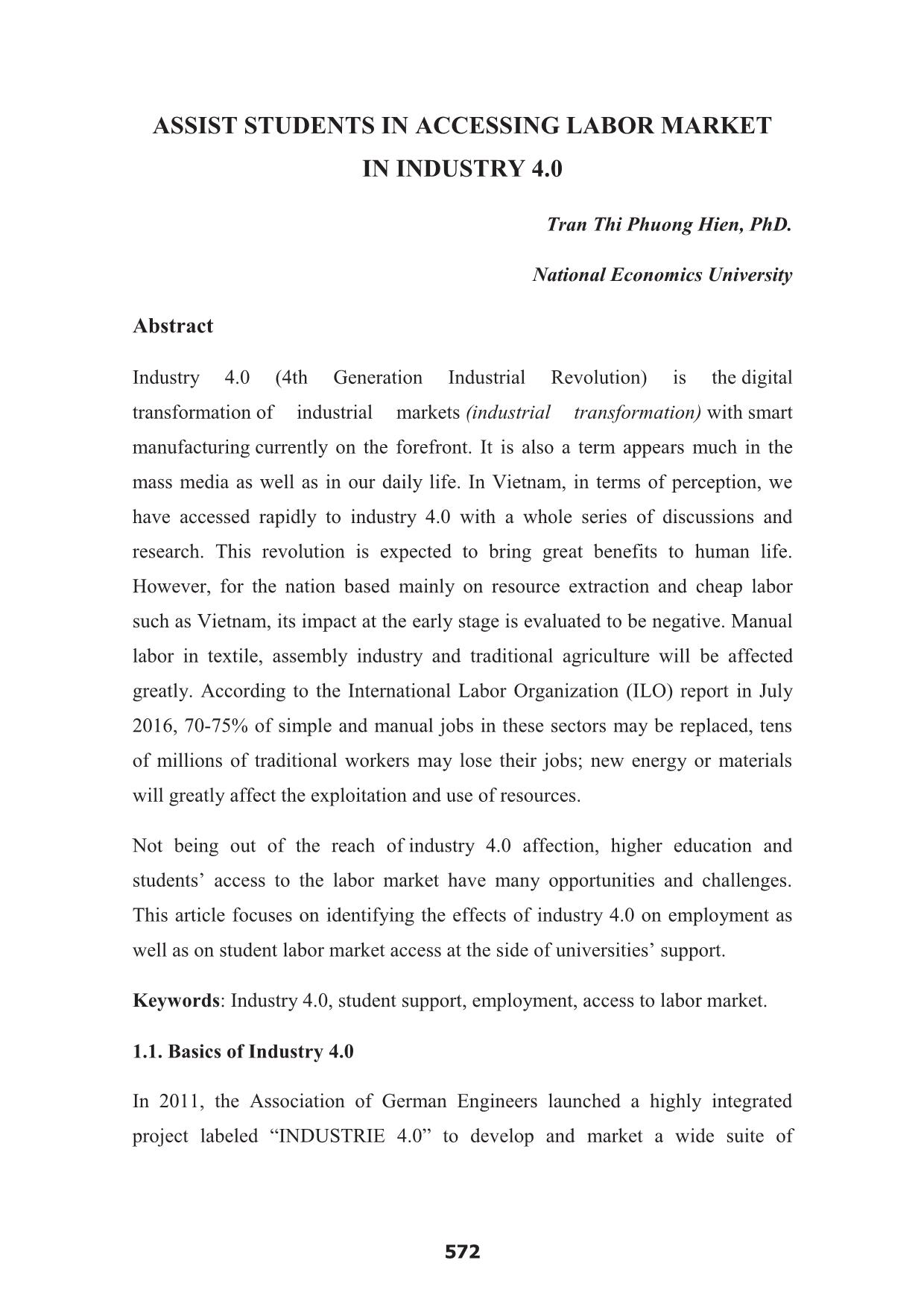
Trang 1

Trang 2
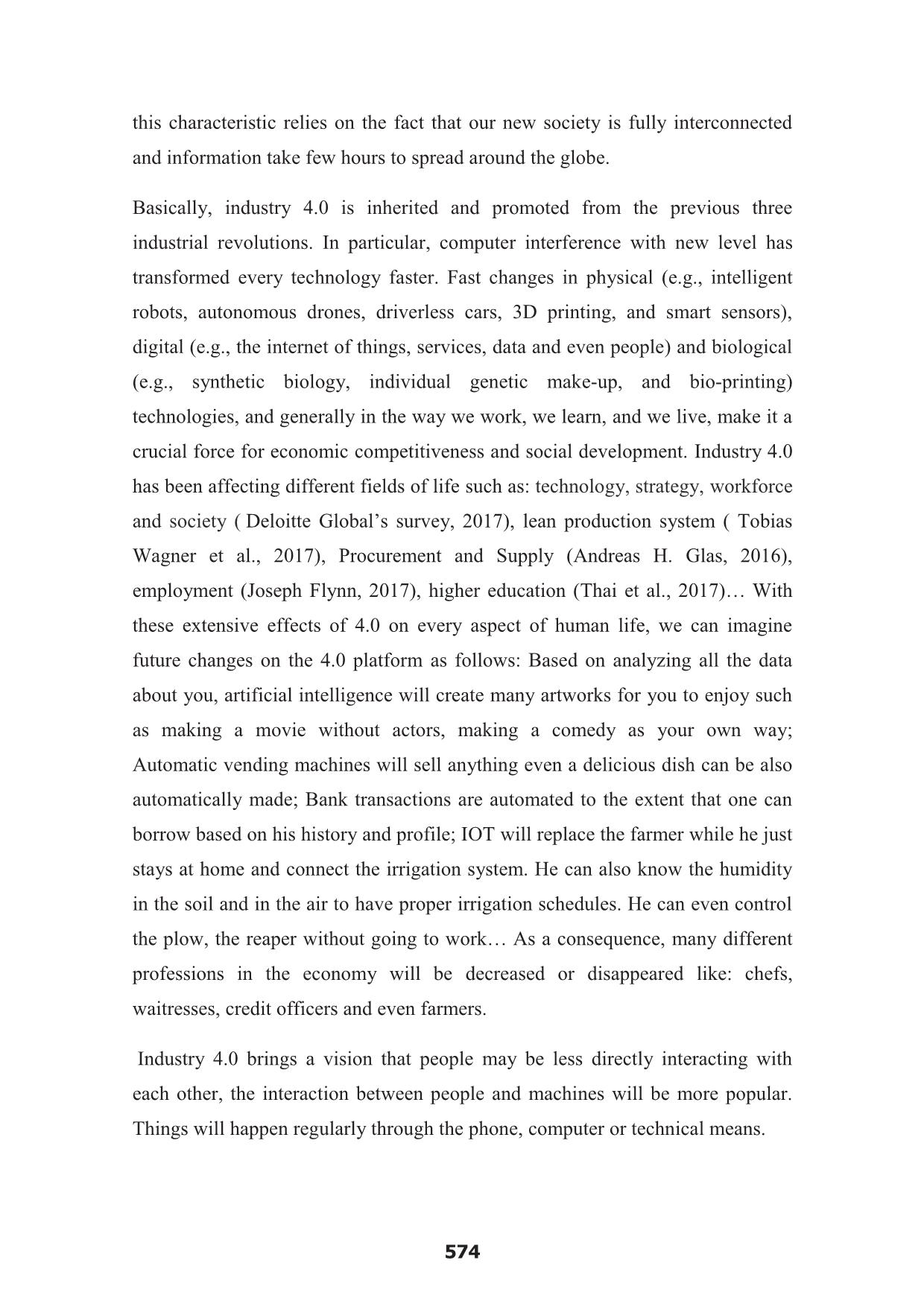
Trang 3
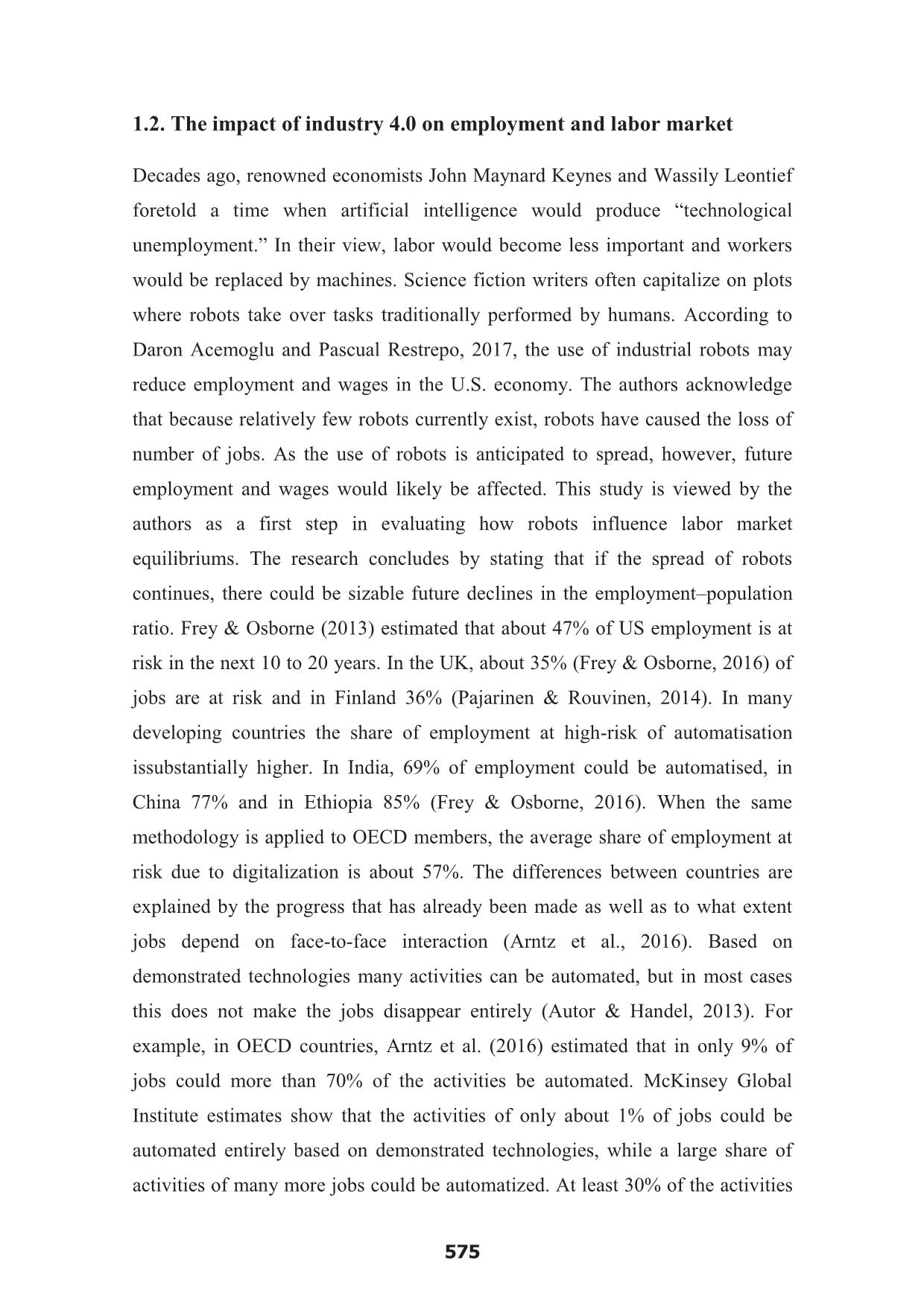
Trang 4
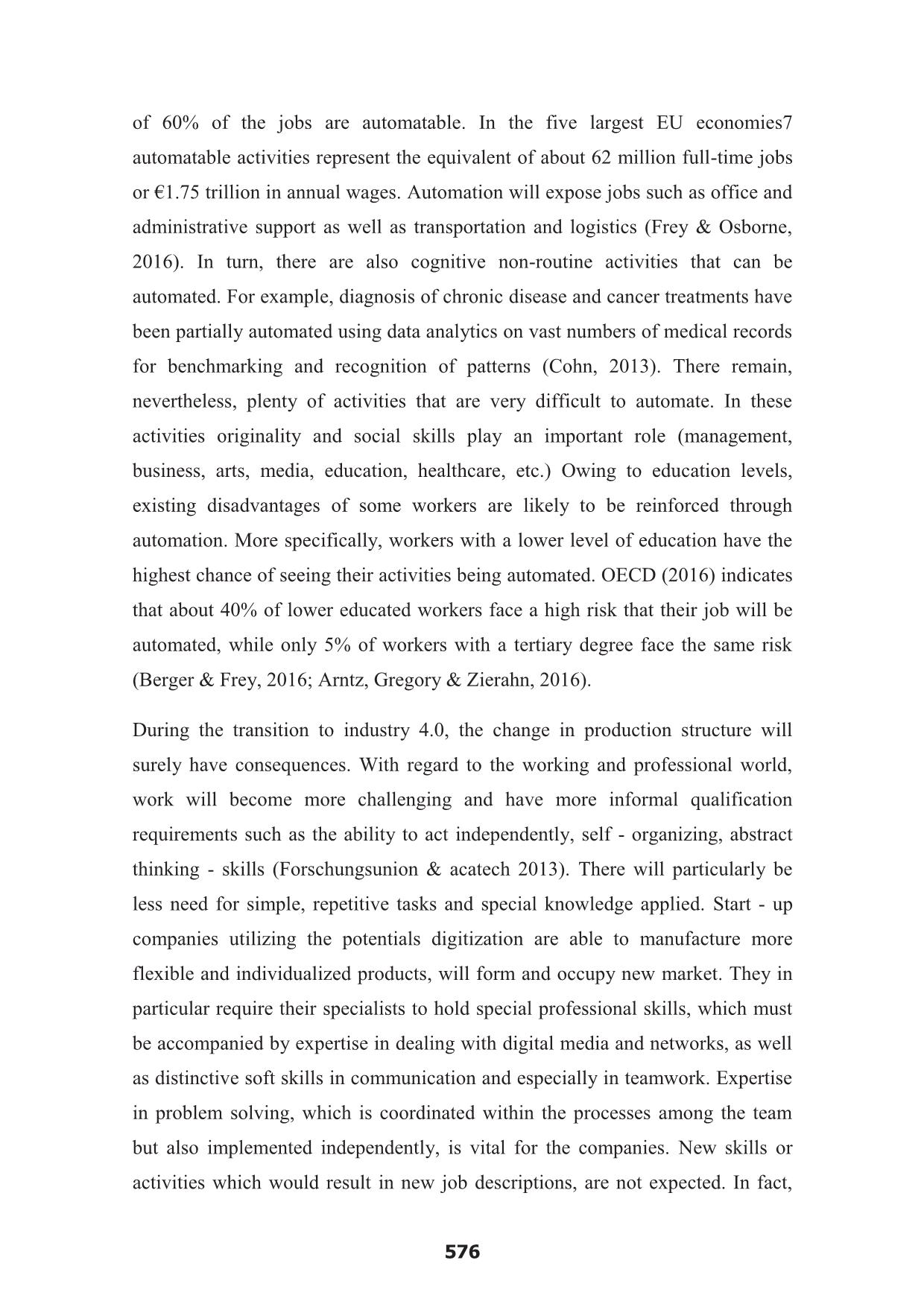
Trang 5
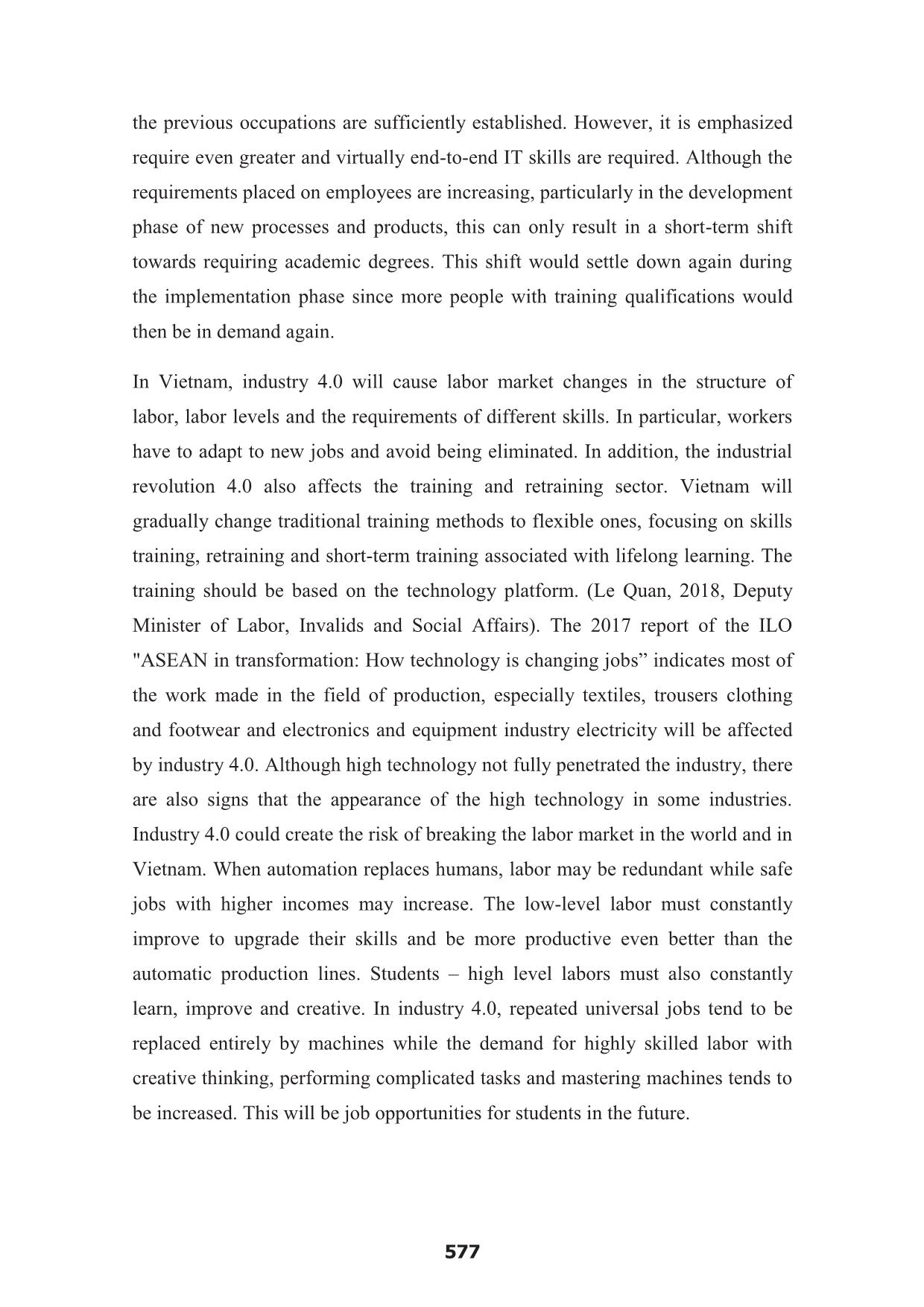
Trang 6
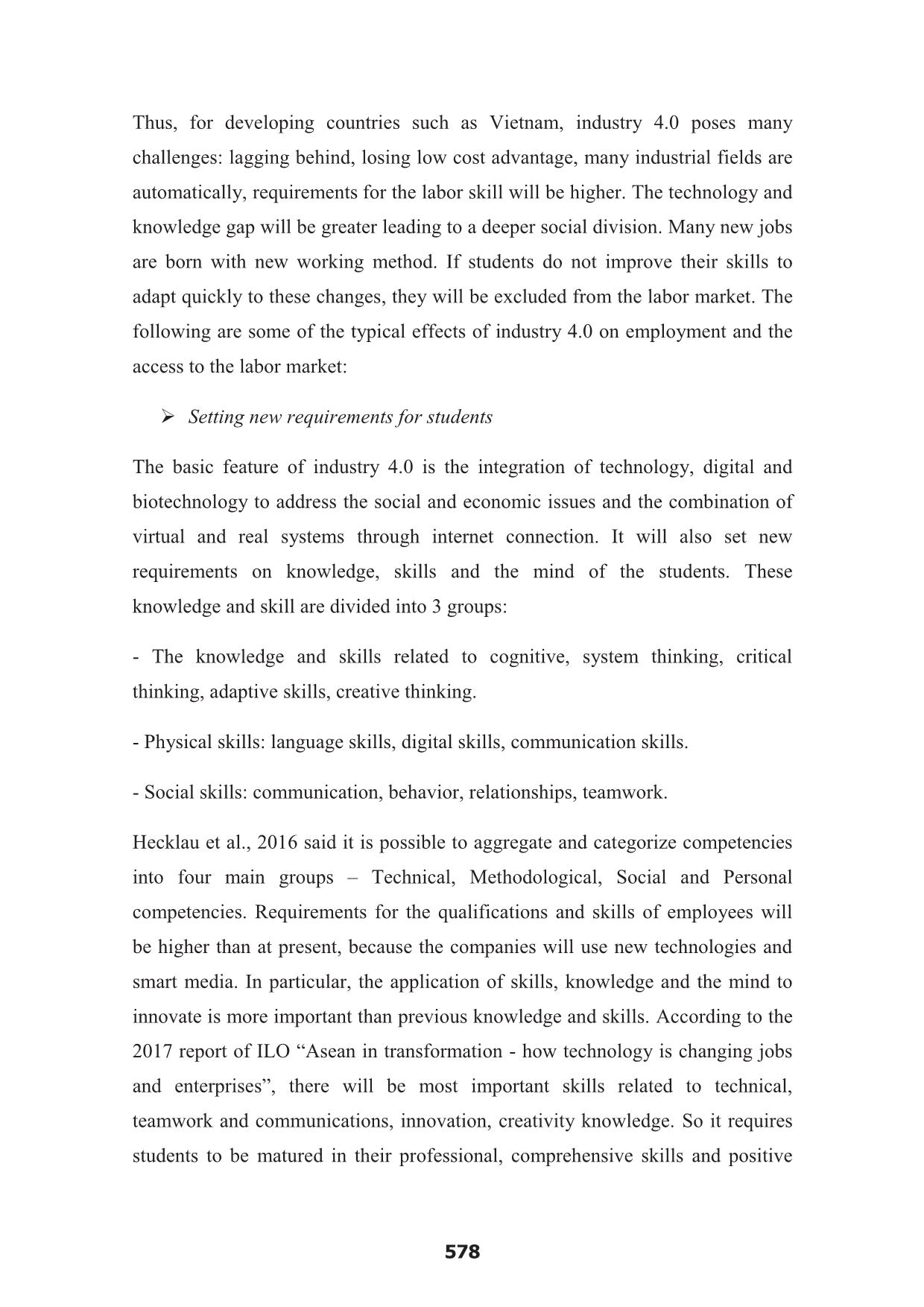
Trang 7
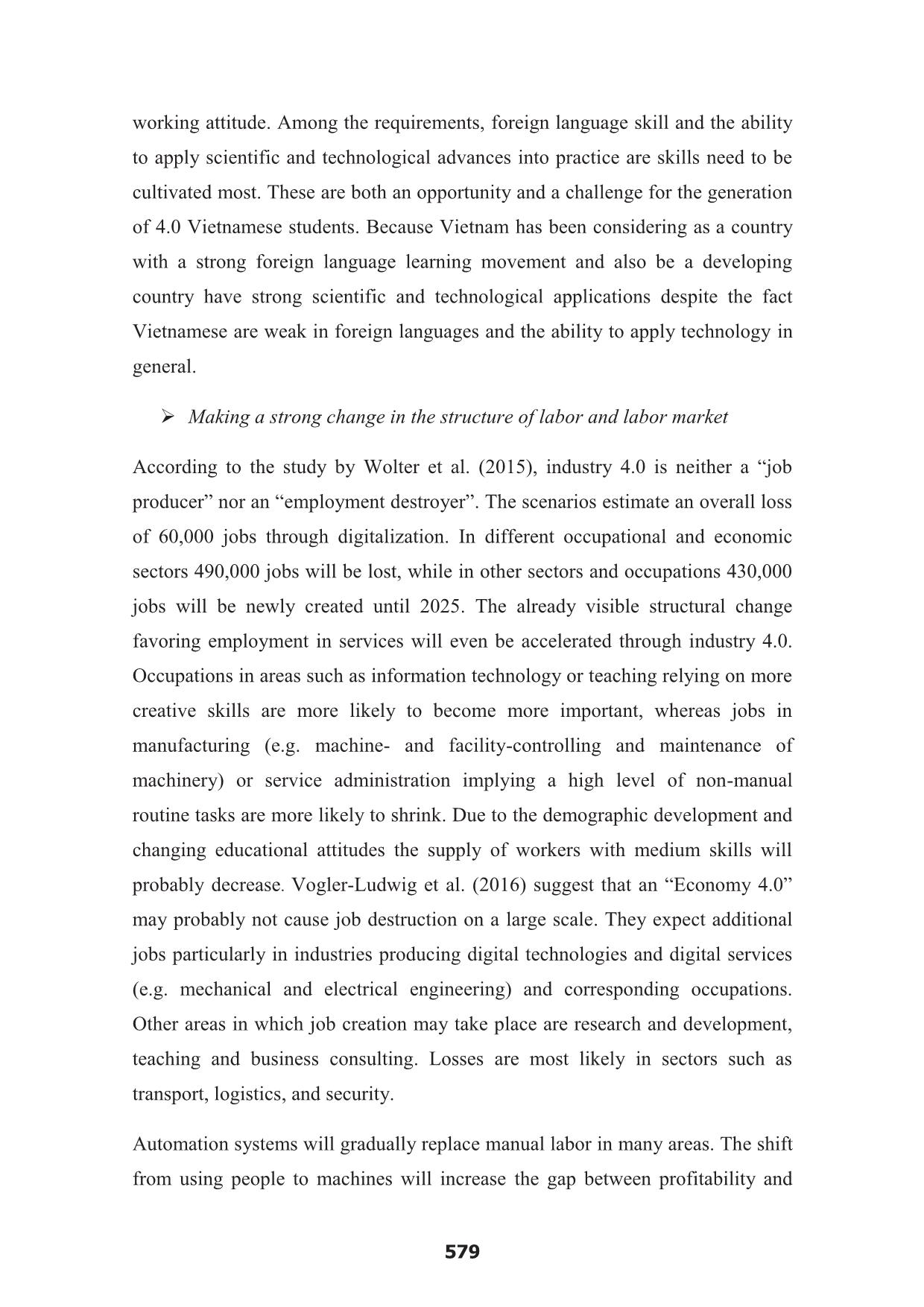
Trang 8
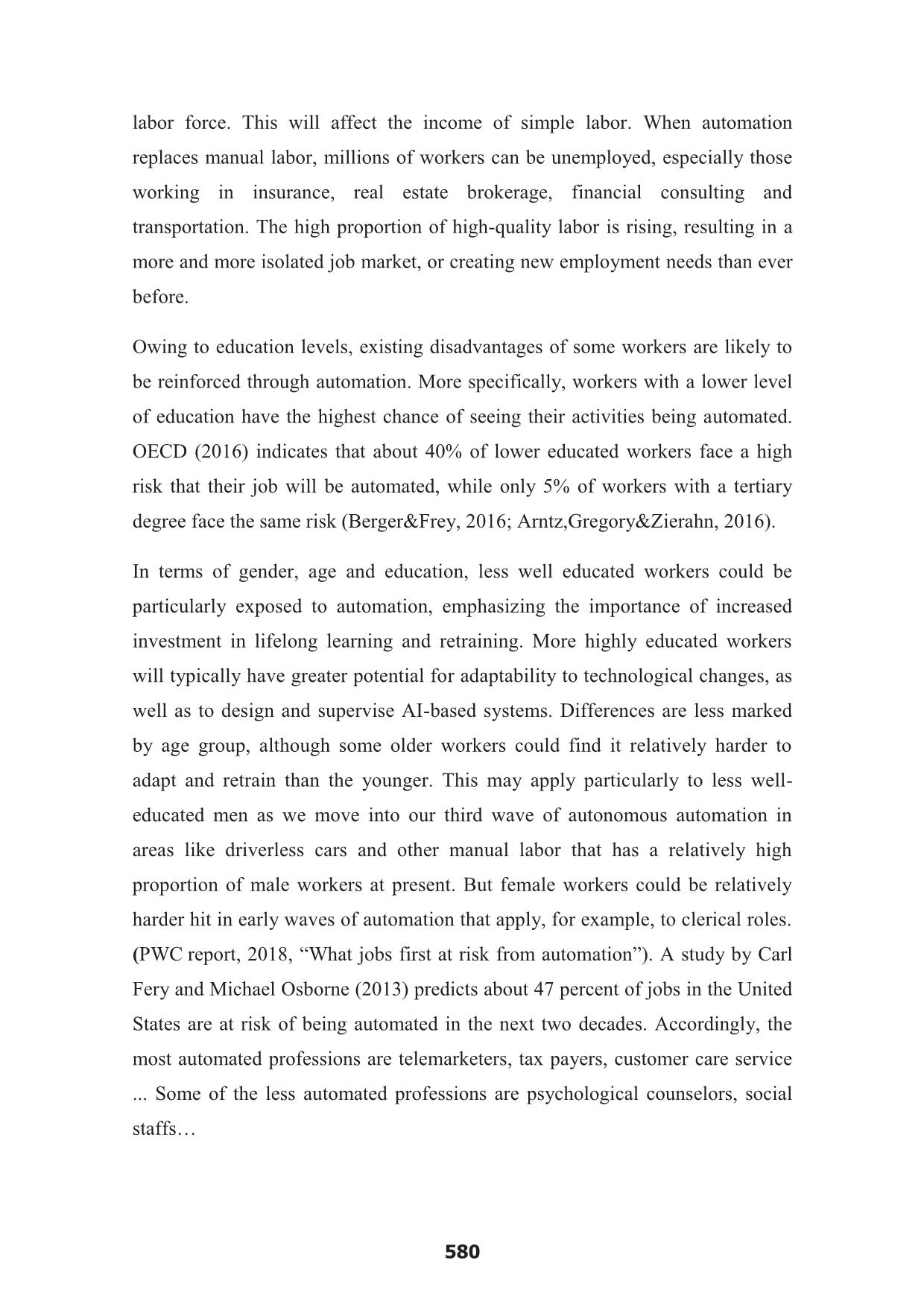
Trang 9
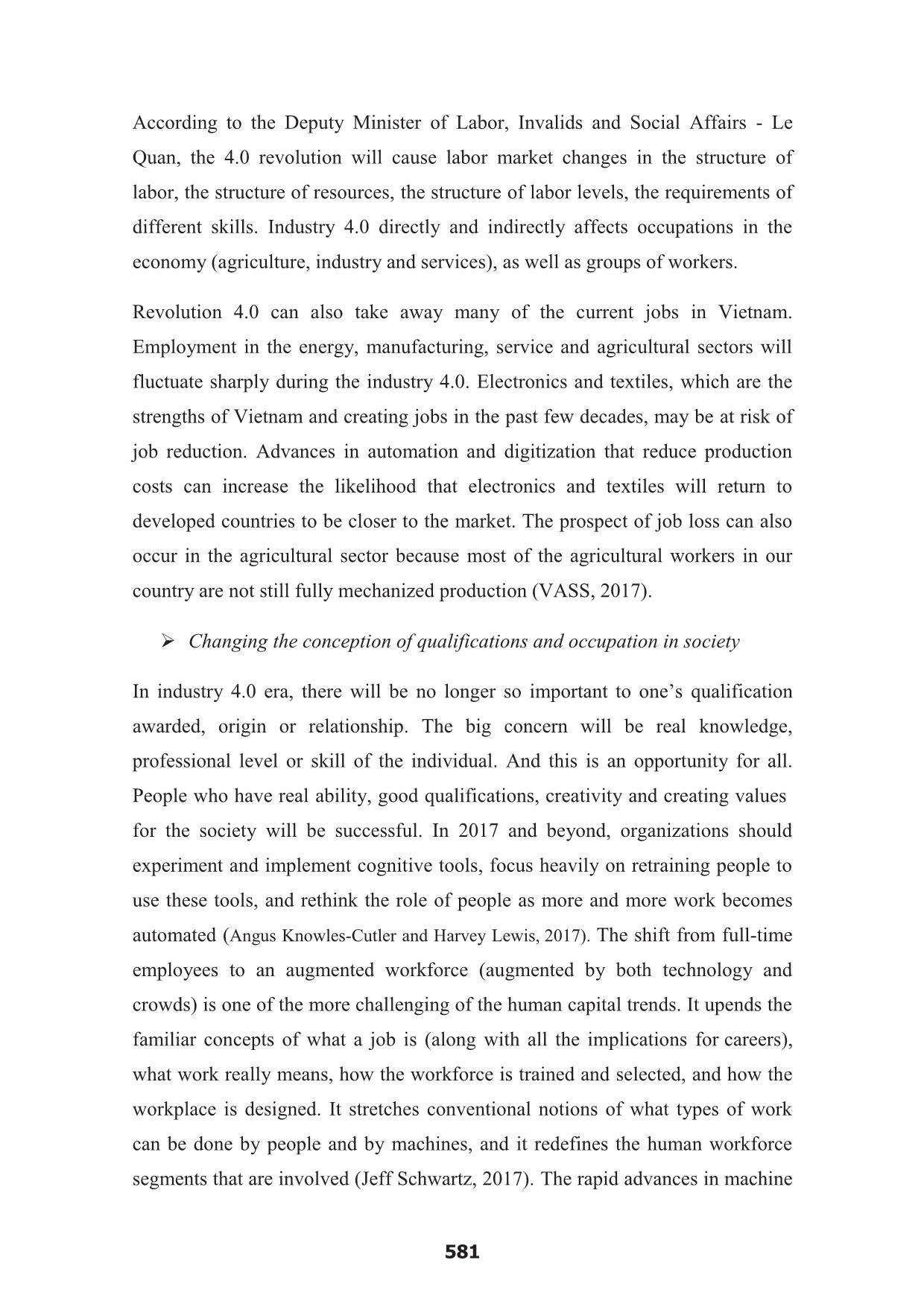
Trang 10
Tải về để xem bản đầy đủ
Tóm tắt nội dung tài liệu: Assist students in accessing labor market in industry 4.0
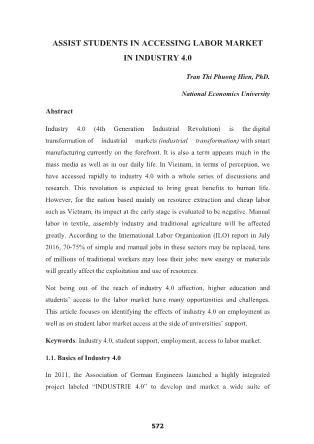
rt to students in accessing the labor market. To do this, the university needs to address the following issues: ¾ About the lecturers: The task of universities in the coming period is to train information technology experts fully, actively equip students with the digital knowledge and related skills to meet the social needs of industry 4.0. Teachers themselves need to master their information technology related to their field of teaching. ¾ About teaching activities: Teachers need to create more appropriate and democratic social contexts for students so that they can debate real issues surrounding their lives. Right from the university, students must be assisted in accumulating knowledge about information technology, timely updating and being able to apply the latest technological advances of the world. It is also essential to equip students with foreign language and soft skills. Most traditional classes now have a disadvantage of high costs, limited space, etc. In the future, these can be replaced by online classes, virtual classrooms and quality control can be made by support tools such as cyberspace connection. Simpler, lecturers can assign homework to groups of students and ask them apply information technology, as well as posting for the pre-class so that the quality of the presentation is guaranteed. ¾ About the curriculum: Most of the current curriculum is not flexible, the content is not suitable with the demand and the labor market trend in industry 4.0. Universities are under pressure when training programs have to be met highly specialization in a certain field and interdisciplinary like information technology, digital, networking. In addition, the curriculum is also under pressure of lacking indispensable skills such as system thinking, ability to synthesize, ability to link between real and virtual worlds, creativity, teamwork skills, 588 interdisciplinary collaboration capacity. Therefore, the curriculum should be designed more diverse, more specific and meet the needs of learners better. ¾ About learning environment: The learning environment is very important for cognitive processes so the ability to design and layout work spaces for students can lead to a new thinking. The learning space needs to be more diversified. Instead of a classroom with walls and tables, traditional labs or simulation rooms, learners can experience cyberspace, interact in real conditions through software and network. The campus should also be arranged open so that students can use the space for meeting, discussing and communicating. Students' leisure space also needs to be concerned to facilitate communication and knowledge sharing. Learning space plays an important role in creating and stimulating, whereas creativity is an important basis for accessing and developing knowledge in the 4.0 era. ¾ About training methods: Training methods should be changed with the strong application of information technology, digital technology and network. Online training, virtual training, simulation, digitizing lectures ... will be the coming training trend. This requires universities to have a good preparation of teaching resources especially lecturers, building learning spaces, teaching and learning equipment. To support students in accessing the labor market, the university needs to organize annual events like exploring knowledge of information technology. From these activities, lecturers and students can have knowledge of information technology from enterprises’ sharing. This is a great way to increase the quality of teaching and learning, and also deepen the relationship between universities and businesses. Universities also need to facilitate to 3rd and 4th year students practice at enterprises. So that students can get acquainted with the new work and technology. The signing of student exchange agreements with foreign countries should be replicated as well. ¾ About training support activities: The learning materials system as well as the library should not only be considered as a specific location. Instead of that, they should be exploited everywhere with simple operation. Computer systems should be equipped enough to assist students in accessing online information. For 589 the best training support, the university needs to establish and maintain an online information system to support students timely. ¾ Strengthening the links with businesses and international universities: universities with typical technique should strengthen these links to build laboratories. These labs are not only a place for students to practice but also an in-depth research center at the enterprise's request to create products and services in order. With universities less technology-specific, strengthening this cooperation is also necessary to accelerate the acquisition of new knowledge of industry 4.0. It depends on the specific capabilities and conditions that they can select the appropriate content and form of link. Research collaboration will provide universities with significant funding to increase science and technology resources and improve the quality of training. Setting up and/or strengthening education center 4.0 and/or student support center: Each university should have a 4.0 education center and/or a student support center. In particular, the 4.0 education center is prepared to take the initiative in responding to challenges and catch up the opportunities from industry 4.0. The student support center is designed to provide timely support to students in their studies and life, as well as providing advice and especially to connect students to employers and labor market. At present, many universities are highly concerned in student support and even have student support center but their size and feature are not matched and be multiple integrated mutually. These centers haven’t helped students much in connecting and finding jobs. Besides, some universities haven’t got the so called “Student support center”. For example, the National Economics University has a Department of Political Affairs and Student Management but this unit does not support students much, especially in supporting to access job opportunities. Other departments have specialized efforts to support students with job opportunities, but it is still very fragmented and ineffective. So the solution that student support centers must play a key role not only in supporting students’ daily problem and job connection but also connecting students actively to employers and giving other career support such as soft skills learning, counseling and career orientation. 590 ¾ Forming a new university model - business university: Promote the partnership between the university and enterprises to change from "teaching what available" to "teaching what the market needs”, or even "teaching what the market will need”. In fact, this solution has been mentioned and concerned but so far few universities perform. On the opposite side, there are businesses set up a professional training in university which is closely linked between theory and practice and have a commitment for job. However, this model has not really been implemented widely. 1.4. Recommendations Although we conducted interviews with a very small group of NEU students, the evidence from the universities’ role and situation of supporting students to the labor market mentioned above indicated that higher education has a key role in helping students access to the labor market better. And students need to have support from the university for the job opportunity better. The goal of education is to train qualified labor to meet the development requirements of the nation, especially in the era of industry 4.0. To do this, the State should continue to improve the law system to create a better environment for human resource development and encouraging the development of high quality human resources. The special policies for leading scientists must be concerned also. And the State should have policies to support the establishment and development of innovative and startup nursery in universities. These nurseries will be closely linked to universities and businesses using high quality human resources. They could become the beginning of ideas, creativity, and give the research results in used. Conclusion To support and connect students to the labor market, universities need to promote the key linkages between school - managers – entrepreneurs so that innovation, creativity and productivity in the knowledge society could be enabled. In order to adapt to the changes of industry 4.0, teaching and learning activities need to be carried out at all times and in all places so that learners could be personalize and 591 completely decide on learning what they need. Universities are not only a place for training and researching but also a center for innovating and solving practical problems. Moreover, universities should be the place brings big value for society and especially have the best support for students to access to the labor market. The universities are not only framed in the walls with tables, classrooms or laboratories but also be expanded in conjunction with businesses and the labor market to become an educational ecosystem. It is believed that students can access to the labor market and get a job easier with the great support of the university. References 1. Andreas H. Glas et al., 2016, The Impact of Industry 4.0 on Procurement and Supply Management: A Conceptual and Qualitative Analysis, International Journal of Business and Management Invention, Volume 5 Issue 6, 55-66. 2. Angus Knowles-Cutler and Harvey Lewis, Essential skills for working in the machine age, Deloitte, https://www2.deloitte.com/uk/en/pages/growth/articles/essential- skills-for-working-in-machine-age.html; Bersin by Deloitte Glassdoor research. 3. Berger, T. and C. Frey (2016), “Structural Transformation in the OECD: Digitalization, Deindustrialization and the Future of Work”, OECD Social, Employment and Migration WorkingPapers,OECDPublishing,Paris. 4. Carl Benedikt Frey and Michael Osborne (2013), The Future of Employment. Oxford Martin School. United Kingdom. https://futureoflife.org/data/PDF/michael_osborne.pdf 5. Daron Acemoglu and Pascual Restrepo, 2017, “Robots and jobs: evidence from US labor markets”, National Bureau of Economic Research working paper no. 23285. 592 6. Deuse, J. et al., Design of Production Systems in the Context of Industry 4.0. In: Botthoff A.,Harmann, E. A .: Future of Work in Industry 4.0. Springer Vieweg, Berlin, 2015. 7. Erik Brynjolfsson, Andrew McAfee, 2016, The Second Machine Age, W. W. Norton & Company, USA. 8. European Economic and Social Committee, 2017, report: Impact of digitalization and the on-demand economy on labour markets and the consequences for employment and industrial relations. 9. Bùi Trung Hải, 2017, “Thách thức với nhân lực Việt Nam trong bối cảnh tác động của cộng đồng kinh tế Asean và cách mạng công nghiệp 4.0, Hội thảo “Đào tạo trực tuyến trong thời kỳ cách mạng công nghiệp 4.0”, ĐHKTQD. 10. Nguyễn Bích Hạnh, Vũ thị Phương Anh,2016, “Năng lực tiếng Anh của sinh viên các trường đại học trước yêu cầu của một nền kinh tế tri thức: thực trạng và những giải pháp”. 11. Hecklau F., Galeitzke M., Flachs S., Kohl H. Holistic Approach for Human Resource Management in Industry 4.0. Procedia CIRP 2016; 54: 1–6. DOI: 10.1016/j.procir.2016.05.102 12. IAB-Forschungsbericht 8/2015, Industry 4.0 and the consequences for labour market and economy. Download of this Forschungsbericht 13. Jeff Schwartz, 2017, The future of work: The augmented workforce https://www2.deloitte.com/insights/us/en/focus/human-capital- trends/2017/future-workforce-changing-nature-of-work.html#endnote-sup-5 14. PWC report, 2018, What jobs first at risk from automation. https://www.pwc.com/hu/en/pressroom/2018/automation_job.html 15. Trinh Thi Hoa Mai, 2008, Training link between university and business in Vietnam, National University of Science journal, Hanoi. 16. Schwab, K. 2015. The Fourth Industrial Revolution. Geneva: World Economic Forum. 593 17. Thai et al., 2017, The 4.0 industrial revolution affecting higher education organizations’ operation in Vietnam, International Journal of Management Technology Vol.4, No 2, pp. 1-12. 18. Dao Trung Thanh, Vu Tuan Anh, 2017, “Hướng nghiêp 4.0”, https://laodong.vn/lao-dong-cuoi-tuan/huong-nghiep-40-619773.ldo. 19. Tobias Wagner et al., 2017, Industry 4.0 impact on lean production systems, Sciendirect 63, 125 – 131. 20. Wolter, M. I.; Mönnig, A.; Hummel, M.; Schneemann, C.; Weber, E.; Zika, G.; Helmrich, R.; Maier, T.; Neuber-Pohl, C. 2015. Industry 4.0 and the consequences for labour market and economy. Scenary calculations in line with the BIBB-IAB qualifications and occupational field projections, IAB- Forschungsbericht No. 8. 21. Vogler-Ludwig, K .; Dull, N .; Kriechel, B. 2016. Labor market 2030. Economy and labor market in the digital age. Forecast 2016. Analysis of future labor demand and supply in Germany based on a calculation model. On behalf of the Federal Ministry of Labor and Social Affairs (Munich, Economix Research & Consulting).). 22. VASS (2017), Cuộc cách mạng công nghiệp lần thứ tư: một số đặc trưng, tác động và hàm ý chính sách đối với Việt Nam. Báo cáo Tổng hợp. Tháng 3/2017. 23. Will Bartlett, 2016, From University to Employment: Higher Education Provision and Labour Market Needs, European Commissioner for Education, Culture, Youth and Sport. 24. https://www.ilo.org/wcmsp5/groups/public/---asia/---ro-bangkok/---ilo- hanoi/documents/publication/wcms_630855.pdf. 25. cach-mang-cong-nghiep-lan-thu-4-va-nhung-van-de-dat-ra-cho-cong-tac- dao-tao-nghien-cuu-khoa-hoc-trong-cac-co-so-giao-duc-dai-hoc.html 26. https://dantri.com.vn/giao-duc-khuyen-hoc/toan-canh-tu-van-top-nganh- nghe-thoi-40-nhieu-viec-lam-20180521141145428.htm 594 27. https://news.zing.vn/cach-mang-cong-nghiep-40-la-gi-post750267.html, accessed on 01/7/2018. 28. https://newsroom.wctc.edu/wctc-and-industry-40-preparing- educatorsstudents-for-tech-careers/ Retrieved 18/7/2018 29. thoi-dai-4-0-9268 Accessed 18 / 7/2018 30. https://thanhnien.vn/gioi-tre/cach-mang-cong-nghiep-40-thoi-co-cua-nguoi- tre-826163.html Retrieved on 18/7/2018 31. Retrieved on 18/7/2018 32. https://baomoi.com/tac-dong-cua-cuoc-cach-mang-cong-nghiep-4-0-doi- voi-co-so-giao-duc-dai-hoc-o-viet-nam- Vientiane-under-viet- nam/c/23125511.epi, Retrieved on 18/7/2018 33. https://www.vietgiaitri.com/tre/hoc-hanh/201805/70-cong-viec-co-nguy-co- bi-thay-the-giao-duc-phai-thay-doi-3195101/ 595
File đính kèm:
 assist_students_in_accessing_labor_market_in_industry_4_0.pdf
assist_students_in_accessing_labor_market_in_industry_4_0.pdf

